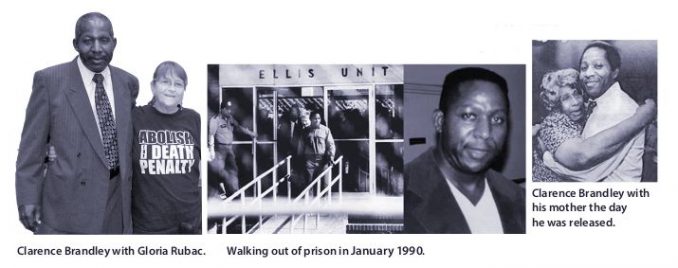Clarence Brandley: A legacy of perseverance and struggle
 Houston — Death row exoneree #40, Clarence Brandley, was honored and remembered at his funeral on Sept. 14. His five children, other relatives, his attorneys, investigators and members of the Coalition to Free Clarence Brandley helped fill the large New Loyalty Missionary Baptist Church in northeast Houston. Dozens of members of his high school graduating class attended, as did Texas Rep. Harold Dutton, who introduces a bill every session to abolish the death penalty. Brandley died Sept. 2 at age 66.
Houston — Death row exoneree #40, Clarence Brandley, was honored and remembered at his funeral on Sept. 14. His five children, other relatives, his attorneys, investigators and members of the Coalition to Free Clarence Brandley helped fill the large New Loyalty Missionary Baptist Church in northeast Houston. Dozens of members of his high school graduating class attended, as did Texas Rep. Harold Dutton, who introduces a bill every session to abolish the death penalty. Brandley died Sept. 2 at age 66.
Brandley was on death row for 10 years after a high school student, Cheryl Dee Fergeson, was murdered at a volleyball tournament in 1980. Brandley was the supervisor of the custodial staff at Conroe High School, 40 miles north of Houston, and the only African American on the staff.
During a supposed investigation, Texas Ranger Wesley Styles told two janitors, “One of you all is going to have to hang for this.” Pointing to Brandley, he said, “Since you’re the n****r, you’re elected.” Six months later Brandley was on Texas death row, convicted by an all-white jury in a town where the KKK still held regular meetings.
Conditions on death row were horrific. In the summer, temperatures in the cells rose to 130 degrees. Medical care was almost nonexistent and the food was awful. Guards were racist, violent and cruel. A group of guards who worked the solitary confinement section called themselves the “White Is Right Squad.”
Brandley joined other prisoners in a chain hunger strike in protest. A couple of prisoners would strike a week or two, and then another two prisoners would take the next weeks. This went on for more than a year.
During that time, the number of people on death row had rapidly grown to well over 400. The entire Texas prison population had seen a big increase as well. The Texas Department of Corrections had been found liable for cruel and unusual punishment, in violation of the U.S. Constitution’s Eighth Amendment, in the historic 1979 Ruiz v. Estelle case. The federal court ordered massive changes in 1980, but Texas prison officials resisted.
Brandley’s family, and particularly his brother Ozell, never gave up on freeing him. Ozell helped form the Coalition to Free Clarence Brandley, which met at Houston’s S.H.A.P.E. Community Center every Tuesday night for years.
“I was always wishing and hoping that someone would just look at the evidence and the facts, because the evidence was clear that I did not commit the crime,” said Brandley from death row.
The coalition relentlessly took every avenue to call attention to the case and build public support. It held mock trials, marched, protested, packed courtrooms, held a freedom ride to major shopping areas and printed T shirts. Group members slept outside the Montgomery County Courthouse while the Klan rode around the square.
The coalition held community forums in Conroe and Houston, and members put cow manure on the steps of the governor’s mansion. They released 100 balloons reading “FREE CLARENCE!” in the rotunda of the Texas Capitol. They met with the Black Legislative Caucus and raised thousands of dollars for investigators.
In 1987 new evidence was discovered, and witnesses finally told the truth. An evidentiary hearing was held in Galveston before retired District Judge Perry Pickett. More than 150 people attended every day for two weeks, coming 85 miles from Conroe and 45 from Houston. “60 Minutes” and “The 700 Club” aired special television programs on the case. Centurion Ministries got involved.
Finally, that October, Judge Pickett declared, in his 30 years as a judge, “No case has presented a more shocking scenario of the effects of racial prejudice, perjured testimony, witness intimidation [and] an investigation the outcome of which was predetermined.” He said two other janitors, both white, were the likely killers, and officials had railroaded Brandley out of racist motives.
He recommended to the state’s Court of Criminal Appeals that a new trial be held. It took that court 14 long months before it finally accepted the recommendation. Texas decided not to retry Brandley.
Clarence walks out — and into organizing
Clarence Brandley walked out of the Ellis Unit prison in January 1990. He spent the next 28 years speaking out against the death penalty.
In small neighborhood churches, universities and the Texas Legislature, Brandley’s story has changed hearts and minds and motivated many to fight for abolition.
Brandley joined Witness To Innocence, an organization composed exclusively of death row exonerees. WTI empowers exonerees to speak out about their own stories and the injustices of capital punishment. They play a powerful role in the movement to abolish the death penalty. (witnesstoinnocence.org)
WTI is sending five exonerees to speak and organize at Texas’s 19th Annual March to Abolish the Death Penalty, to be held on Oct. 20. Brandley spoke at the march for many years. As Brandley had done, these exonerees will speak to university students, religious institutions and legislators while in Texas.
Brandley’s case sparked worldwide interest in the death penalty. British writer Nick Davies came to Texas to write an article, stayed for an extended period and wrote a compelling book, “White Lies: Rape, Murder and Justice Texas Style.” The Showtime television network made a movie based on the book. Davies attended the funeral.
Clarence Brandley will be missed by so many for his quick smile and honesty, ability to captivate any audience and dedication to abolish the racist death penalty.

